May-21-11
 | | AylerKupp: Game Score: Houdini 1.5a (Golden Executive) vs. Rybka 4.1 (AylerKupp), May-21-11, Gruenfeld Defense, Exchange Variation. A good game. Rybka pressured Houdini's pawn center as is normal in this variation and obtained an outside passed pawn plus a B vs. N ending where Rybka's bishop controlled the passed pawn's queening square.. I thought that the game was in the bag but Houdini managed to get into a position where Rybka couldn't prevent Houdini from capturing its next to last pawn if it went after its remaining passed k-side pawns, and then there would be nothing to prevent Houdini from sacrificing its knight against Rybka's last pawn. Dang! Rybka evaluated the game as equal by move 14 and then its eval of its position quickly climbed to [-0.50] by move 26. Its eval went up and down slightly until move 45 where it stabilized at [-0.76] or [-0.77] until move 56, where it climbed to [-0.94] and stayed that way until the end of the game. In the simplified position Rybka was able to achieve search depths of 29-34 which is unusual, in a normal middle game it seldom exceeds d=19. 1.d4 Nf6 2.c4 g6 3.Nc3 d5 4.cxd5 Nxd5 5.e4 Nxc3 6.bxc3 Bg7 7.Nf3 O-O 8.Be2 c5 9.O-O b6 10.Be3 Bb7 11.Qc2 cxd4 12.cxd4 e6 13.Rac1 Nc6 14.Qb2 Rc8 15.Bb5 Qd6 16.a3 Rfd8 17.e5 Qf8 18.Ng5 h6 19.Nh3 Ne7 20.Nf4 Nf5 21.Rxc8 Rxc8 22.Bd7 Rb8 23.Bb5 Qd8 24.Rc1 Rc8 25.Rxc8 Qxc8 26.a4 Qa8 27.Bf1 Bc6 28.Qb4 Qb7 29.Ne2 a5 30.Qb3 b5 31.axb5 Qxb5 32.Qxb5 Bxb5 33.Nc3 Bc6 34.Bb5 Bxb5 35.Nxb5 Nxe3 36.fxe3 a4 37.Kf1 Bf8 38.Nc3 a3 39.Ke2 f6 40.exf6 Kf7 41.Kd3 Kxf6 42.h3 Kf5 43.g3 h5 44.Kc2 e5 45.e4+ Kg5 46.dxe5 Bg7 47.Kb3 Bxe5 48.Ne2 Bd6 49.Ka2 Kf6 50.Nf4 h4 51.Nd5+ Ke5 52.gxh4 Kxe4 53.Nf6+ Kf5 54.Nd7 Ke6 55.Nb6 Bb4 56.Nc4 Bc5 57.Nd2 Kd5 58.Kb3 Bf8 59.Nf3 Bd6 60.Ka2 Ke4 61.Ng5+ Kf5 62.Nf7 Be7 63.Nh6+ Ke6 64.Ng4 Kd5 65.Ne3+ Ke5 66.Nc4+ Kf4 67.Kb3 Bc5 68.Ka2 Kf5 69.Kb3 Ke4 70.Ka2 Kd4 71.Nd2 Kd3 72.Nf3 Bd6 73.Ng5 Be7 74.Nf3 Ke4 75.Nd2+ Kf4 76.Nc4 Bf8 77.Kb3 Bb4 78.draw agreed Final position:

click for larger view
My thoughts on the game and a discussion of my pre-game preparation later when I have some time. |
|
May-22-11
 | | AylerKupp: Houdini vs. Rybka, May-21-11 Pre-Game preparations.
Although I consider this tournament to be just for fun, I do have a certain competitive streak and, being retired, some time on my hands. So, since I had 2 weeks between games I decided to take advantage of the time and try to determine if there were any openings that Houdini didn't play well in its games against Rybka. First I downloaded all the latest CCRL 40/40 Houdini vs. Rybka games (41 total) and saw that the record was a dismal 18 wins (43.8%) Houdini, 3 wins (7.3%) Rybka, and 20 draws (48.8%). Talk about intimidating! I also broke it down by opening. Eleven different openings were represented. Rybka did relatively well with the French (2 wins, 1 loss, 6 draws), broke even with the QGD classical (2 draws) and QGD Slav (1 draw), but did miserably with everything else. Since there were a limited number of games and a relatively large number of different openings, I decided to try something else. I ran a series of 49 tournament games between Houdini (white) against Rybka (black) under various time controls, from 5 minutes to 120 minutes each. The results were equally intimidating; 29 wins (58.8%) for Houdini, 5 wins (10.2%) for Rybka, and 15 draws (30.6%). Apparently having White is a big advantage in engine vs. engine tournaments. So I decided that since Rybka had a ½ game lead in the tournament with 2 rounds to go, if Rybka with the Black pieces drew with Houdini, it would have a reasonably good chance of winning with the White pieces against Stockfish two weeks later, giving Rybka a good chance of winning the tournament. There's that competitive streak of mine surfacing. I also wanted an interesting, semi-open game with chances for both sides, so I narrowed the number of openings to 5: Benoni, Gruenfeld, and QGD against 1.d4 and French and Sicilian against 1.e4. Although Rybka didn't do well with the French in these games (8 losses, 1 win, 3 draws), it reasonably well in the CCRL 40/40 tournament so that's what I would have played had <Golden Executive> opened with 1.e4. Besides, <Golden Executive> and I are currently on opposite sides of the chessgames.com Team White against Team Black game (a French MacCutcheon) so I was curious how that might turn out in a strict engine vs. engine game. Against 1.d4 Rybka did best with the Gruenfeld, 1 win (11.1%), 4 losses (44.4%), and 4 draws (44.4%). Also pretty intimidating unless you remember that as far as this game was concerned I considered a draw to be as good as a win. Of the 9 Gruenfelds, there were 5 exchange variations played. Rybka's record was even better than with the Gruenfeld as a whole, 1 win (20%), 2 losses (40%) and 2 draws (40%), the best record with any of the openings and variations in the tournament. So what did my good friend <Golden Executive> do? He opened 1.d4 and played the exchange variation of the Gruenfeld. Talk about my good fortune! And Rybka came very close to winning the game. I'll follow this post with my comments on the game itself. |
|
| May-24-11 | | Golden Executive: <AylerKupp> You (and your Deep A4) killed my 1.d4 dream... http://www.youtube.com/watch?featur.... Please excuse me about my belated response, I will post my comments and analysis as soon as possible. p.s. This game I went from big smile to big worry face. After reading about your game preparation I must say: Phew !! (as usual :)). |
|
May-24-11
 | | AylerKupp: <<Golden Executive:> <AylerKupp> You (and your Deep A4) killed my 1.d4 dream> Great and appropriate video! And don't worry about responding, take your time. I have also started looking at the game but I'm very busy at the moment and haven't been able to spend enough time on the game (I'm only on move 18!). Too bad you didn't find a video with the Audi A6 in it, that would have been even more appropriate. And if you had found a video on the Audi A8 then you would have really been in trouble! |
|
Jun-02-11
 | | AylerKupp: Game Score and comments: Houdini 1.5a (Golden Executive) vs. Rybka 4.1 (AylerKupp), May-21-11, Gruenfeld Defense, Exchange Variation, part 1 of 6. Finally, enough time to comment on the game. As usual by now, I set the Arena GUI to 93 minutes/game to give me 12 minutes to deal with Clock Lag. I entered the first 8 moves myself rather than allowing Rybka to play the first 8 moves and this time it wasn't difficult since there aren't that many different Gruenfeld lines for the first 8 moves, particularly in the exchange variation. So I was confident that I wouldn't stick Rybka with an inferior position as a result of my lack of up-to-date opening knowledge. Again, the game score will be easier to read if you copy it to Word, change the spaces to tabs, and adjust the tab setting appropriately. White Black Eval Depth Time
1. d4 Nf6 - - -
2. c4 g6 - - -
3. Nc3 d5 - - -
4. cxd5 Nxd5 - - -
5. e4 Nxc3 - - -
6. bxc3 Bg7 - - -
7. Nf3 O-O - - -
8. Be2 c5 - - -
Here I turned it over to Rybka to make its first move and wasn't surprised when it evaluated White's position as slightly superior. White position is solid with a pawn center typical of the Gruenfeld exchange variation although 7.Bc4 and 9.Ne2 are probably more aggressive. Black has a queenside pawn majority and is ready to start the typical attack against White's center.
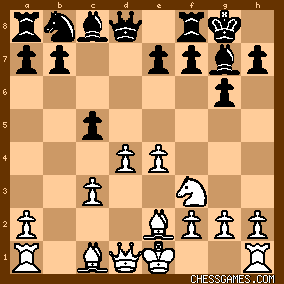
click for larger viewBut, just like with the game against Hosea/Schiller/Wall, I had a glitch during the handover that caused both me and <Golden Executive>me to have to recreate the first 8 moves and then turn it over to the engines. I need to figure out the cause of the problem before the next game, but I didn't do anything different during the second handover than I did during the first, so I'm perplexed. White Black Eval Depth Time
9. O-O b6 +0.26 17 154
10. Be3 Bb7 +0.20 17 122
11. Qc2 cxd4 +0.22 19 213
12. cxd4 e6 +0.22 18 91

click for larger view
Rybka I thought played remarkably well in putting pressure against White's center, with a combination of attack and restraint. I could have sworn that the ghost of Nimzovitch was playing the Black pieces! And White's queen is now exposed on c2 and must move again. |
|
Jun-02-11
 | | AylerKupp: Houdini 1.5a vs. Rybka 4.1, May-21-11, part 2 of 6.
White Black Eval Depth Time
13. Rac1 Nc6 +0.14 18 15
14. Qb2 Rc8 0.00 18 270
15. Bb5 Qd6 -0.03 19 243
16. a3 Rfd8 -0.18 19 60
17. e5
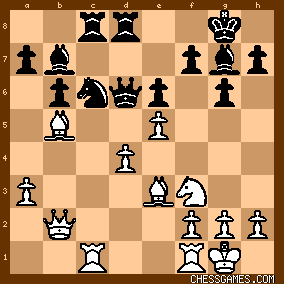
click for larger view
A small victory for Black, I said at the time. White has been forced to immobilize its center pawns and hand over the center light squares to Black with a wonderful outpost for Black's knight or LSB bishop at d5. But how else would White have defended its Pd4, attacked 4 times and defended only 3 times, particularly since 17.d5 is not feasible? If instead 17.Rfd1 Rybka evaluated the position after 17. ... Ne7 18.Rxc8 Rxc8 19.Bd3 f5 20.e5 Qd8 21.Ne1 Bf8 22.h3 Nd5 23.Bd2 Rc7 24.Be2 Qc8 25.Bf3 Rc4 26.Be2 Rc6 27.Bf3 Rc7 28.a4 Qd7 29.Ra1 Ba6 30.a5 at [-0.23], d=27

click for larger view
The d4 pawn is again backward and both of black's bishops have fine diagonals and after 30...b5 a passed pawn that is ready to advance. At this point I think Rybka properly evaluated the position as slightly advantageous to Black, with its next move positively Karpovian, moving its queen to the back rank while keeping White's queen busy defending the Pa3 and leaving the e7 square available for the knight. White Black Eval Depth Time
17. ... Qf8 -0.16 18 30
18. Ng5 h6 -0.26 18 164

click for larger view
A slight weakening of the k-side pawns which I didn't think was necessary since White wasn't really threatening anything. The knight has nothing useful to do on g5 and will soon move again of its own free will (assuming that knight moves determined by computers have free will), either to h3 as in the game or to f3 after White's f4 (which probably wouldn't be all that great since it really locks in White's DSB and the chances for f4-f5 are probably slim). But the limiting of Black's DSB scope by preventing ...Bh6 and the locking in of Black's king will have later consequences in the endgame. Yet Rybka's evals started to climb in its favor. White Black Eval Depth Time
19. Nh3 Ne7 -0.27 18 0
20. Nf4 Nf5 -0.25 18 0
21. Rxc8 Rxc8 -0.30 14 8
22. Bd7 Rb8 -0.42 18 17

click for larger view
22...Rc7 would have been more aggressive and saved a tempo. But Rybka's evals continued to climb in its favor. |
|
Jun-02-11
 | | AylerKupp: Houdini 1.5a vs. Rybka 4.1, May-21-11, part 3 of 6.
White Black Eval Depth Time
23. Bb5 Qd8 -0.40 19 75
24. Rc1 Rc8 -0.38 18 84
25. Rxc8 Qxc8 -0.36 18 23
26. a4 Qa8 -0.50 18 208
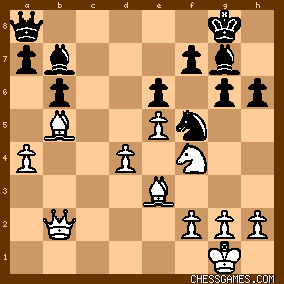
click for larger view
A Pogonina queen for those that remember The World vs. N.Pogonina when she moved her LSB to a8. But I think it was Reti who first moved his queen to a1 behind the fianchettoed bishop on b2 to put pressure on the long diagonal. Rybka was so "proud" of this move that raised it's eval of Black's position by 14 centipawns. White Black Eval Depth Time
27. Bf1 Bc6 -0.50 16 5
28. Qb4 Qb7 -0.64 19 267
29. Ne2 a5 -0.77 21 173
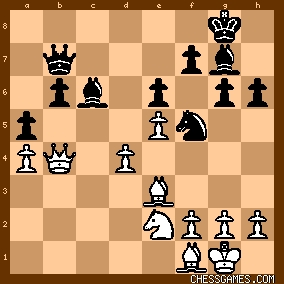
click for larger view
A surprising move that caught that caught both me and <Golden Executive> by surprise. But Black gets an outside passed pawn. The high point of Rybka's eval for its position until much later. White Black Eval Depth Time
30. Qb3 b5 -0.70 21 6
31. axb5 Qxb5 -0.73 22 0
32. Qxb5 Bxb5 -0.73 18 42
33. Nc3 Bc6 -0.55 23 0
34. Bb5 Bxb5 -0.55 20 34
35. Nxb5 Nxe3 -0.55 21 57
36. fxe3 a4 -0.49 25 74

click for larger view
I thought this should be a won ending for Black. White's k-side pawn majority is crippled and Black's bishop will have plenty of room to operate on the q-side. White's king and knight will be tied up preventing the advance of the a-pawn and Black's king should be able to get to the k-side and gobble up White's pawns along the dark squares. And, importantly (or so I thought at the time), Black's bishop is the same color as the a-pawn's queening square. |
|
Jun-02-11
 | | AylerKupp: Houdini 1.5a vs. Rybka 4.1, May-21-11, part 4 of 6.
White Black Eval Depth Time
37. Kf1 Bf8 -0.48 27 161
38. Nc3 a3 -0.48 25 28
39. Ke2 f6 -0.49 26 128
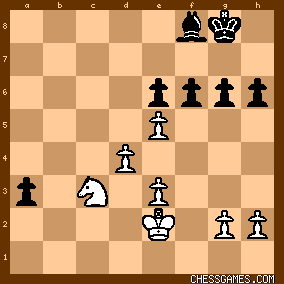
click for larger view
The first indication that Rybka does not understand the need for the superior side (and I consider Black the superior side at this point in spite of the material equality) to preserve as many pawns as possible in an endgame. So perhaps 39...Be7 was better with the idea of bringing out Black's king via 40...Kf8-e8-c6. At this point Rybka had about 47 minutes remaining on its clock. I don't know how much time Houdini had on its clock but I suspect that it was the same or less, since Houdini tends to spend more time when it evaluates its position as inferior, as I suspect it did at this point. Rather than try to analyze the position after 39...Be7 by either engine or by a 3rd engine, I set up the position and had Houdini and Rybka play each other several times from this point forward. To try to duplicate the game conditions as closely as possible, since I conveniently have a 4-core computer and 4 GB RAM, I set each engine to use no more than 2 cores with Ponder = ON, and a 512 MB hash table. That way each engine could calculate possible replies while the other engine was calculating its next move without interference. I also tried additional games with Ponder = OFF and with different time controls. The results were interesting. Rather than the expected string of 0-1's, with a 47 minute time control, Ponder = ON, and each engine restricted to 2 cores and a 512 MB hash table, there were 2 wins by Rybka and 4 draws. With a 47 minute time control, Ponder = OFF and each engine allowed to use 4 cores Rybka won once and drew once. With 30 and 60 minute time controls Rybka won once (30 min) and drew twice (60 mins each time). The total score was Rybka 4 wins and 7 draws. So obviously the win, while possible, was not as easy as it seemed to me at the time. White Black Eval Depth Time
40. exf6 Kf7 -0.49 26 0
41. Kd3 Kxf6 -0.49 26 118
42. h3 Kf5 -0.49 22 0
43. g3 h5 -0.49 21 0
44. Kc2 e5 -0.49 21 0

click for larger view
Here I started to be concerned. I didn't see the need to exchange this pawn and would have preferred that Rybka had played 44...Bd6, exchanging the a-pawn for White's g-pawn and breaking up White's k-side pawns. Then Black's king can get to White's h-pawn giving Black 2 connected passed pawns on the k-side. But I thought that this was still a win for Black. |
|
Jun-02-11
 | | AylerKupp: Houdini 1.5a vs. Rybka 4.1, May-21-11, part 5 of 6.
White Black Eval Depth Time
45. e4+ Kg5 -0.76 23 0
46. dxe5 Bg7 -0.76 25 31
47. Kb3 Bxe5 -0.77 28 161
48. Ne2 Bd6 -0.77 27 99
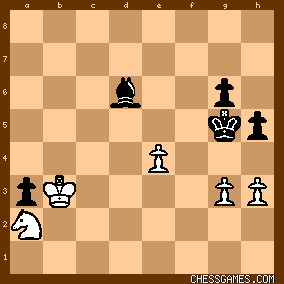
click for larger view
Rybka calculated a long time for the last 2 moves but I think that the position is drawn at this point since Black can't penetrate the k-side pawn barrier without further pawn exchanges. White Black Eval Depth Time
49. Ka2 Kf6 -0.77 29 29
50. Nf4 h4 -0.77 28 43
51. Nd5+ Ke5 -0.77 28 31
52. gxh4 Kxe4 -0.77 29 41
53. Nf6+ Kf5 -0.77 31 15
54. Nd7 Ke6 -0.77 32 21
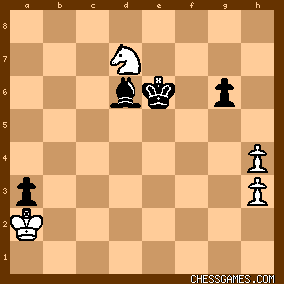
click for larger view
Here Rybka tries to push White's knight to the q-side before trying to go after the k-side pawns which are now vulnerable. Maybe 54...Kf4 going after the Ph3 immediately is better. But 54...Kf4 55.Ng6 Kg3 doesn't work because of 56.Ne4+. And 54...Be7 to guard both the f8 and f6 squares doesn't work either since once Black's king moves to g3 White has Ne5 attacking the Pg6. White's king can move between a2 and b3 and Black can't make any progress. Black's problem is that it needs to keep White's knight away from the Pg6. If White's knight can capture it then it can sac itself for the advanced a-pawn. In order to prevent that Black needs to capture both White h-pawns and get the Pg6 to a dark square where it can be protected by the bishop. Since the number of pieces is reduced Rybka can search at deeper plies so I was still somewhat optimistic that it had calculated everything. White Black Eval Depth Time
55. Nb6 Bb4 -0.77 33 18
56. Nc4 Bc5 -0.94 33 106

click for larger view
Black's strategy is now obvious; take squares away from the White knight so that it can't threaten the Pg6. Given the deeper search depths that Rybka was now able to achieve, I felt really optimistic since Rybka is rather conservative compared to some other engines and does not tend to overestimate its eval. So Rybka's eval jump to almost a full pawn advantage let me to believe that it had seen everything to the game's conclusion. Alas, that's as high as Rybka's evals ever got. |
|
Jun-02-11
 | | AylerKupp: Houdini 1.5a vs. Rybka 4.1, May-21-11, part 6 of 6.
White Black Eval Depth Time
57. Nd2 Kd5 -0.94 33 2
58. Kb3 Bf8 -0.94 31 108
59. Nf3 Bd6 -0.94 33 72
60. Ka2 Ke4 -0.94 34 21
61. Ng5+ Kf5 -0.94 34 0
62. Nf7 Be7 -0.94 34 9
63. Nh6+ Ke6 -0.94 33 18
64. Ng4 Kd5 -0.94 30 74
65. Ne3+ Ke5 -0.94 31 6
66. Nc4+ Kf4 -0.94 31 68

click for larger view
Black's king is finally advancing towards the White k-side pawns and my hopes were raised again. White Black Eval Depth Time
67. Kb3 Bc5 -0.94 33 95
68. Ka2 Kf5 -0.94 31 68
69. Kb3 Ke4 -0.94 32 73
70. Ka2 Kd4 -0.94 34 113
71. Nd2 Kd3 -0.94 32 0
72. Nf3 Bd6 -0.94 34 1
73. Ng5 Be7 -0.94 31 18
74. Nf3 Ke4 -0.94 29 4
75. Nd2+ Kf4 -0.94 33 72
76. Nc4

click for larger view
But now it's obvious even to me that there's nothing more there. If the bishop moves away from the a3-f8 diagonal the Pa3 falls. If the bishop stays on the a3-f8 diagonal and the Black king moves to g3, then Ne5 picks up the Pg6. And Black can't get White into zugswang because White can move its king between a2 and b3 as needed. White Black Eval Depth Time
76. ... Bf8 -0.94 32 0
77. Kb3 Bb4 -0.94 30 67
½-½

click for larger view
A rather dramatic and kind of human-like final move by Rybka to demonstrate the futility of trying to win from this position. Maybe Rybka was hoping for 78.KxB?? when 78...a2 queens. It might have worked against a human opponent with less one second left in its clock. It might even have worked against Houdini if it had less than a microsecond on its clock and could only go to a depth of 3 plies since it would only have seen 78.KxB a2 79.(White any) and evaluated the position as superior for itself since it was a piece up. Oh well, a nice try by Rybka. And I hope that Houdini is sufficiently encouraged by its endgame performance to uphold the honor of the silicon units against the carbon units in its next game. |
|
|
|
|





